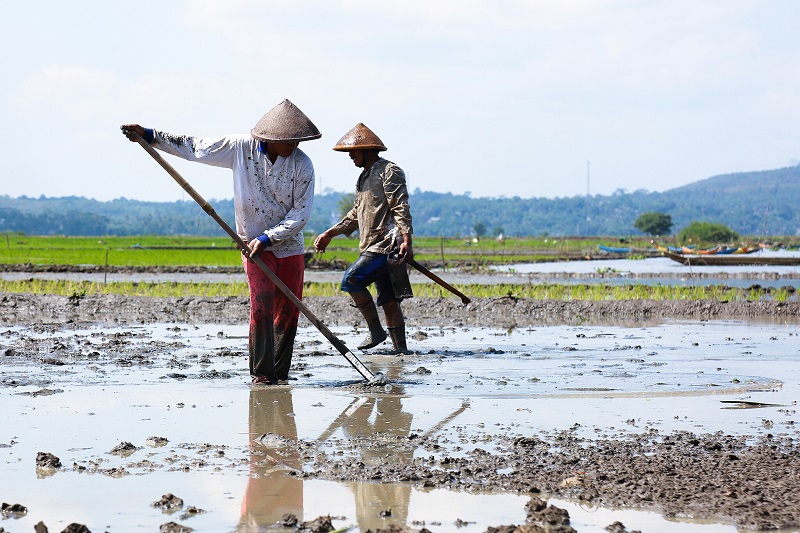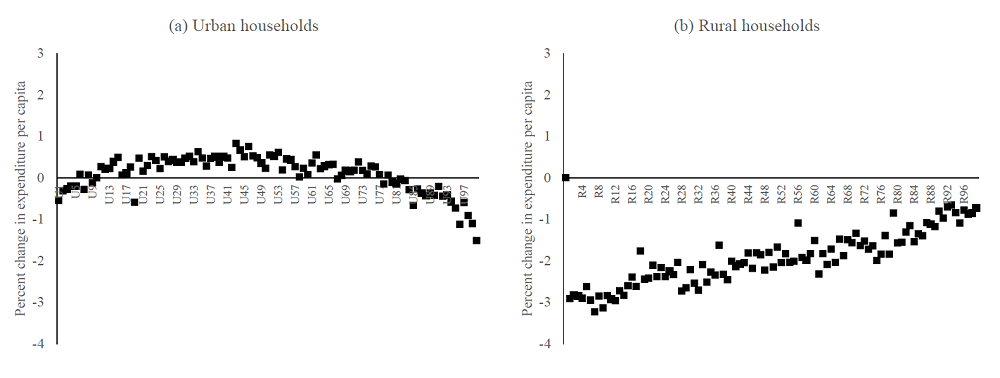IDE Research Columns
Column
Pandemic-induced De-urbanization in Indonesia

January 2024
Our recent study provides evidence based on economic modeling that in Indonesia, the negative economic impact of COVID-19 fell more heavily on rural households than is generally supposed. After the pandemic’s initial negative impact on urban employment, a second-round impact involved the temporary relocation of urban-based workers to rural areas in search of agricultural employment. We call this de-urbanization. It depressed agricultural wages and thereby harmed rural households, especially the poorest. These conclusions are supported by recent labor market data.
Overview
In Indonesia, as in other developing countries, the negative health impact of COVID-19 has been largest in urban areas, not rural areas. A heavy urban concentration is also evident in the direct loss of employment resulting from the government’s program of shutdowns, mobility restrictions, and social distancing requirements. Although these summary facts are correct, they are incomplete and potentially misleading. A hitherto overlooked second-round consequence of the loss of urban employment was a huge migration of low-skilled and semi-skilled workers from nonagricultural to agricultural employment in search of income, food, and safety from the pandemic, which we call de-urbanization.
The de-urbanization phenomenon is not new to Indonesia. Historically, the agricultural sector has often served as an economic shock absorber, providing short- or medium-term employment to urban workers who lose their jobs during economic downturns. The 1997–1999 Asian financial crisis is a good example. With COVID-19, de-urbanization has happened again.
De-urbanization
Our analysis divides the full labor market effects of the pandemic into three components: reduced employment, underemployment, and de-urbanization. We analyze the magnitudes of these three effects, as observed in the available labor market data, using an empirically-based general equilibrium model of the Indonesian economy. It is important that the construction of the labor market shocks we apply to the general equilibrium model is based on empirical evidence, and not on arbitrary guesswork.
De-urbanization is likely to be temporary, but its duration depends on the future course of the pandemic, still unknown. In reversing the long-term historical process of urban expansion, de-urbanization can be understood in the context of the Harris–Todaro migration model: the COVID-19 pandemic caused increased urban unemployment, but it did not directly affect rural employment. Urban industry and service wages are sticky downwards, whereas unregulated rural agricultural labor markets clear, albeit with potentially very low wages. The immediate effect of the pandemic was to reduce the expected income from remaining in urban areas, leading to an urban-to-rural migration.
De-urbanization was an adaptive response to reduced urban incomes, temporarily abating but not eliminating the economic hardship urban households would otherwise have experienced. Nevertheless, it placed the migrating workers in economic competition with the least skilled agricultural workers, expanding their numbers by approximately 8%. By increasing the supply of unskilled farm labor, de-urbanization depressed unskilled farm workers’ real wages to an extent depending on the elasticity of demand for farm labor—the more inelastic the demand, the larger the real wage decline. The available evidence suggests this elasticity is quite low—well below one in absolute value, implying that the total wage income of unskilled farm workers, aggregated across all of these workers, fell as their numbers increased. The big losers were the rural households depending on this source of income. On average, these households are by far the poorest in the country.
In the fast-growing literature on the pandemic’s impact on developing countries, these second-round labor market phenomena have been ignored. Recognizing the de-urbanization response to increased urban unemployment challenges the prevailing view that the pandemic’s negative economic impact, including its impact on poverty, is concentrated in urban areas. Conversely, it is significant that not all unemployed urban workers were able to make a temporary transition to rural employment. Hence, at least some of the non-adjusting urban households may have been the most negatively affected of all.
In many cases, perhaps most, a sectoral shift from urban to rural employment also entails a relocation from urban to rural residence. In some cases, unemployed urban workers can commute to agricultural jobs. In other cases, workers in industry and manufacturing had previously commuted from rural residence to urban employment. When workers from urban households move from nonagricultural to agricultural employment, our analysis continues to treat them, and all other members of their households, as still belonging to their original “urban” households, regardless of whether their new residence is urban or rural. Therefore, it is important that the central result of our study—that the relocation of employment from industry and services to unskilled farm labor reduces the real wages of the latter—does not depend on whether the relocating workers reside in urban or rural areas.
Qualifications
The labor market events analyzed in our study were important manifestations of the pandemic, but these labor market events were not the only relevant impacts of the pandemic. We focus on variables that can be observed from the available labor market data to construct empirically-based labor supply shocks. We analyze the impact of these shocks on consumer demand, economic structure, poverty, and inequality, ceteris paribus, holding constant aspects of the pandemic that did not occur endogenously as a result of labor market impacts. This analysis is conducted using an internally consistent, empirically-based general equilibrium model of the Indonesian economy.
Our findings indicate that the effects of de-urbanization dominated the effects of reduced employment and underemployment. De-urbanization induced a large reduction in real agricultural wages, thereby increasing poverty among rural households that depend on unskilled farm labor. Nevertheless, it must be recognized that aspects of the pandemic’s overall effect that did not operate through labor markets could accentuate, mitigate, or reverse some of the outcomes projected by our simulations, as subsequent evidence will presumably reveal.
Supporting Evidence
Notwithstanding this important qualification, recent wage data from the Indonesian government’s Labor Force Surveys confirm the movement of real wages in the direction indicated by our analysis but at a smaller magnitude. Between August 2019 and August 2020, the real hourly wages of urban manufacturing increased by 2.6%, whereas those of agricultural manufacturing declined by 6.0%. Factors not captured by our analysis may have moderated, but did not eliminate, the urban–rural relative wage outcomes implied by our analysis.
Implications
Figure 1 summarizes the findings on the estimated impact of the three labor market shocks on urban and rural households. The horizontal axis of panel (a) shows, from the left, 100 urban households (U1 to U100), arranged from the centile with the lowest initial expenditure per person (U1) to the highest (U100). Panel (b) shows 100 rural households (R1 to R100), arranged in the same manner. The vertical axes show the estimated percentage changes in real household expenditures caused by the three labor market shocks combined. The most important observation is that rural households were more negatively affected, especially the poorest.

Figure 1. Simulated Changes in Real Household Expenditures per Person.
Source: Authors’ calculations from simulation results.
The three labor market impacts we analyzed reveal a combined increase in the total number of people below Indonesia’s poverty line of 1.03 million, of which 0.87 million (85% of the total) resided in rural areas. De-urbanization alone accounts for 56% of the projected increase in rural poverty. Our findings are relevant for social protection in Indonesia—a major policy issue. If social protection measures concentrate on the apparent losers from the pandemic (those in urban areas), the areas of greatest economic hardship caused by the pandemic (rural areas) could be overlooked. Similar findings may also apply to other pandemic-affected developing economies with large agricultural sectors.
Authors’ Note
This column is based on Warr, Peter and Arief Anshory Yusuf. 2023. “Pandemic-Induced Deurbanization in Indonesia: Urban and Rural Impacts.” Forthcoming in Developing Economies. https://doi.org/10.1111/deve.12392
About the Authors
Dr. Peter Warr is the John Crawford Professor of Agricultural Economics, Emeritus, at the Australian National University. His research includes general equilibrium modeling of the Indonesian, Lao, and Thai economies, particularly regarding the relationship between economic policy and poverty incidence.
Dr. Arief Anshory Yusuf is a Professor of Economics at the Department of Economics, Padjadjaran University, Bandung, Indonesia. He is a Research Affiliate at the Department of International Development of King’s College, University of London, and an Honorary Senior Lecturer at the Crawford School of Public Policy of the Australian National University. His research focuses on the economic development of Indonesia, particularly poverty and inequality, as well as on the interlinkage between the economy and the environment.
* The views expressed in the columns are those of the author(s) and do not represent the views of IDE or the institutions with which the authors are affiliated.
** Thumbnail image: Petani mengolah sawah (Mjnspt, CC BY-SA 4.0, via Wikimedia Commons)

